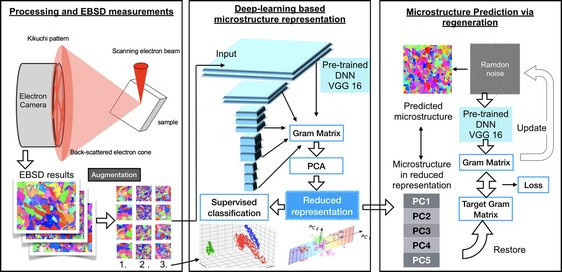Crossref Citations
This article has been cited by the following publications. This list is generated based on data provided by
Crossref.
Gunasegaram, D.R.
Murphy, A.B.
Barnard, A.
DebRoy, T.
Matthews, M.J.
Ladani, L.
and
Gu, D.
2021.
Towards developing multiscale-multiphysics models and their surrogates for digital twins of metal additive manufacturing.
Additive Manufacturing,
Vol. 46,
Issue. ,
p.
102089.
Baskaran, Arun
Kautz, Elizabeth J.
Chowdhary, Aritra
Ma, Wufei
Yener, Bulent
and
Lewis, Daniel J.
2021.
Adoption of Image-Driven Machine Learning for Microstructure Characterization and Materials Design: A Perspective.
JOM,
Vol. 73,
Issue. 11,
p.
3639.
Small, Kathryn A.
and
Taheri, Mitra L.
2021.
Role of Processing in Microstructural Evolution in Inconel 625: A Comparison of Three Additive Manufacturing Techniques.
Metallurgical and Materials Transactions A,
Vol. 52,
Issue. 7,
p.
2811.
Chen, Chengxi
Wong, Stanley Jian Liang
Raghavan, Srinivasan
and
Li, Hua
2022.
Design of experiments informed deep learning for modeling of directed energy deposition process with a small-size experimental dataset.
Materials & Design,
Vol. 222,
Issue. ,
p.
111098.
Zhang, Ying
and
Fiona Zhao, Yaoyao
2022.
A Web-based automated manufacturability analyzer and recommender for additive manufacturing (MAR-AM) via a hybrid Machine learning model.
Expert Systems with Applications,
Vol. 199,
Issue. ,
p.
117189.
Martinez Ostormujof, T.
Purushottam Raj Purohit, R.R.P.
Breumier, S.
Gey, N.
Salib, M.
and
Germain, L.
2022.
Deep Learning for automated phase segmentation in EBSD maps. A case study in Dual Phase steel microstructures.
Materials Characterization,
Vol. 184,
Issue. ,
p.
111638.
Breumier, S.
Martinez Ostormujof, T.
Frincu, B.
Gey, N.
Couturier, A.
Loukachenko, N.
Aba-perea, P.E.
and
Germain, L.
2022.
Leveraging EBSD data by deep learning for bainite, ferrite and martensite segmentation.
Materials Characterization,
Vol. 186,
Issue. ,
p.
111805.
Srivastava, Manu
Rathee, Sandeep
Patel, Vivek
Kumar, Atul
and
Koppad, Praveennath G.
2022.
A review of various materials for additive manufacturing: Recent trends and processing issues.
Journal of Materials Research and Technology,
Vol. 21,
Issue. ,
p.
2612.
Qin, Jian
Hu, Fu
Liu, Ying
Witherell, Paul
Wang, Charlie C.L.
Rosen, David W.
Simpson, Timothy W.
Lu, Yan
and
Tang, Qian
2022.
Research and application of machine learning for additive manufacturing.
Additive Manufacturing,
Vol. 52,
Issue. ,
p.
102691.
Stubblefield, G. G.
Fraser, K. A.
Robinson, T. W.
Zhu, N.
Kinser, R. P.
Tew, J. Z.
Cordle, B. T.
Jordon, J. B.
and
Allison, P. G.
2023.
A computational and experimental approach to understanding material flow behavior during additive friction stir deposition (AFSD).
Computational Particle Mechanics,
Vol. 10,
Issue. 6,
p.
1629.
Zhang, Ying
Safdar, Mutahar
Xie, Jiarui
Li, Jinghao
Sage, Manuel
and
Zhao, Yaoyao Fiona
2023.
A systematic review on data of additive manufacturing for machine learning applications: the data quality, type, preprocessing, and management.
Journal of Intelligent Manufacturing,
Vol. 34,
Issue. 8,
p.
3305.
Mukherjee, T.
Elmer, J.W.
Wei, H.L.
Lienert, T.J.
Zhang, W.
Kou, S.
and
DebRoy, T.
2023.
Control of grain structure, phases, and defects in additive manufacturing of high-performance metallic components.
Progress in Materials Science,
Vol. 138,
Issue. ,
p.
101153.
Ciccone, Francesco
Bacciaglia, Antonio
and
Ceruti, Alessandro
2023.
Optimization with artificial intelligence in additive manufacturing: a systematic review.
Journal of the Brazilian Society of Mechanical Sciences and Engineering,
Vol. 45,
Issue. 6,
Xames, Md Doulotuzzaman
Torsha, Fariha Kabir
and
Sarwar, Ferdous
2023.
A systematic literature review on recent trends of machine learning applications in additive manufacturing.
Journal of Intelligent Manufacturing,
Vol. 34,
Issue. 6,
p.
2529.
Chaurasia, Nikhil
Jha, Shikhar Krishn
and
Sangal, Sandeep
2023.
A novel training methodology for phase segmentation of steel microstructures using a deep learning algorithm.
Materialia,
Vol. 30,
Issue. ,
p.
101803.
Xie, Jiarui
Sage, Manuel
and
Zhao, Yaoyao Fiona
2023.
Feature selection and feature learning in machine learning applications for gas turbines: A review.
Engineering Applications of Artificial Intelligence,
Vol. 117,
Issue. ,
p.
105591.
Shao, Jiayun
Samaei, Arash
Xue, Tianju
Xie, Xiaoyu
Guo, Shengmin
Cao, Jian
MacDonald, Eric
and
Gan, Zhengtao
2023.
Additive friction stir deposition of metallic materials: Process, structure and properties.
Materials & Design,
Vol. 234,
Issue. ,
p.
112356.
Wang, Mengjie
and
Kashaev, Nikolai
2024.
On the maintenance of processing stability and consistency in laser-directed energy deposition via machine learning.
Journal of Manufacturing Systems,
Vol. 73,
Issue. ,
p.
126.
Ng, Wei Long
Goh, Guo Liang
Goh, Guo Dong
Ten, Jyi Sheuan Jason
and
Yeong, Wai Yee
2024.
Progress and Opportunities for Machine Learning in Materials and Processes of Additive Manufacturing.
Advanced Materials,






